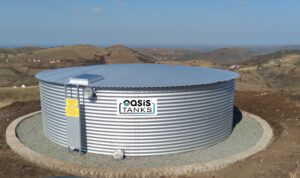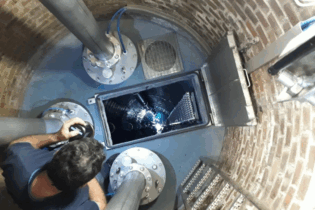Most water reservoirs have curved surfaces with a spherical, paraboloid or cylindrical shape. Such round tanks enjoy structural advantages over tanks with square or rectangular surfaces.
 By Quinton Coetzee, director, Rainbow Reservoirs
Round water storage tanks are often preferred for their structural integrity, material efficiency and easier cleaning.
Structural strength
A round structure is the strongest geometrical structure and stronger than straight-sided, box-like alternatives. Round tanks distribute the pressure of the stored water more evenly across their surface, leading to greater structural integrity. This is particularly important for large tanks that need to withstand significant weight loads. A round structure can therefore more successfully withstand the outward-directed force of the water stored within and the force of wind and rain exerted from the outside.
Material efficiency
They also take up less surface area than a box-shaped tank yet hold the same volume of water. A cylindrical water tank has the least possible ratio of circumference to area, it has less surface area than a box-shaped water tank that holds the same amount of water. For this reason, a spherical water tank requires less building material than its box-shaped equivalent and is consequently more economical to build. Furthermore, due to their structural strength they need less additional reinforcement than box shaped tanks.
By Quinton Coetzee, director, Rainbow Reservoirs
Round water storage tanks are often preferred for their structural integrity, material efficiency and easier cleaning.
Structural strength
A round structure is the strongest geometrical structure and stronger than straight-sided, box-like alternatives. Round tanks distribute the pressure of the stored water more evenly across their surface, leading to greater structural integrity. This is particularly important for large tanks that need to withstand significant weight loads. A round structure can therefore more successfully withstand the outward-directed force of the water stored within and the force of wind and rain exerted from the outside.
Material efficiency
They also take up less surface area than a box-shaped tank yet hold the same volume of water. A cylindrical water tank has the least possible ratio of circumference to area, it has less surface area than a box-shaped water tank that holds the same amount of water. For this reason, a spherical water tank requires less building material than its box-shaped equivalent and is consequently more economical to build. Furthermore, due to their structural strength they need less additional reinforcement than box shaped tanks. Constant heat level
In a round tank, the surface area is primarily concentrated on the cylindrical portion, with minimal area on the top and bottom. This reduction in surface area helps to minimize heat loss, evaporation, and material exposure to external elements. This means that round tanks keep the enclosed water at a more constant temperature than box-like structures. They therefore lose less heat in winter and gain less heat during the summer. Cleaning and hygiene Round tanks have smooth, continuous surfaces without corners or edges, which makes cleaning easier. In contrast, box-shaped tanks have corners and crevices where dirt, debris, and microbial growth can accumulate, making cleaning more challenging. Corners in tanks are known to harbour microbes. Efficient water circulation The circular motion of water within a round tank promotes more efficient circulation, which can help prevent stagnation and improve water quality.








